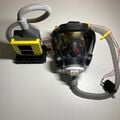J.M.Pearce (talk | contribs) |
(Set shorter title-tag for SEO purposes) |
||
| (8 intermediate revisions by 5 users not shown) | |||
| Line 1: | Line 1: | ||
{{MOST}} | {{MOST}} | ||
[[ | [[File:Covid19.JPG|thumb]] | ||
{{Source data | |||
| type = Paper | |||
| cite-as = Pearce JM. A review of open source ventilators for COVID-19 and future pandemics. ''F1000Research'' 2020, 9:218 (https://doi.org/10.12688/f1000research.22942.2) [https://www.academia.edu/42386090/Open_Peer_Review_A_review_of_open_source_ventilators_for_COVID-19_and_future_pandemics academia open access] | |||
}} | |||
Coronavirus Disease 2019 (COVID-19) threatens to overwhelm our medical infrastructure at the regional level causing spikes in mortality rates because of shortages of critical equipment, like ventilators. Fortunately, with the recent development and widespread deployment of small-scale manufacturing technologies like RepRap-class 3-D printers and open source microcontrollers, mass distributed manufacturing of ventilators has the potential to overcome medical supply shortages. In this study, after providing a background on ventilators, the academic literature is reviewed to find the existing and already openly-published, vetted designs for ventilators systems. These articles are analyzed to determine if the designs are open source both in spirit (license) as well as practical details (e.g. possessing accessible design source files, bill of materials, assembly instructions, wiring diagrams, firmware and software as well as operation and calibration instructions). Next, the existing Internet and gray literature are reviewed for open source ventilator projects and designs. The results of this review found that the tested and peer-reviewed systems lacked complete documentation and the open systems that were documented were either at the very early stages of design (sometimes without even a prototype) and were essentially only basically tested (if at all). With the considerably larger motivation of an ongoing pandemic, it is assumed these projects will garner greater attention and resources to make significant progress to reach a functional and easily-replicated system. There is a large amount of future work needed to move open source ventilators up to the level considered scientific-grade equipment, and even further work needed to reach medical-grade hardware. Future work is needed to achieve the potential of this approach by developing policies, updating regulations, and securing funding mechanisms for the development and testing of open source ventilators for both the current COVID19 pandemic as well as for future pandemics and for everyday use in low-resource settings. | |||
Coronavirus Disease 2019 (COVID-19) threatens to overwhelm our medical infrastructure at the regional level causing spikes in mortality rates because of shortages of critical equipment, like ventilators. Fortunately, with the recent development and widespread deployment of small-scale manufacturing technologies like RepRap-class 3-D printers and open source microcontrollers, mass distributed manufacturing of ventilators has the potential to overcome medical supply shortages. In this study, after providing a background on ventilators, the academic literature is reviewed to find the existing and already openly-published, vetted designs for ventilators systems. These articles are analyzed to determine if the designs are open source both in spirit (license) as well as practical details (e.g. possessing accessible design source files, bill of materials, assembly instructions, wiring diagrams, firmware and software as well as operation and calibration instructions). Next, the existing Internet and gray literature are reviewed for open source ventilator projects and designs. The results of this review found that the tested and peer-reviewed systems lacked complete documentation and the open systems that were documented were either at the very early stages of design (sometimes without even a prototype) and were essentially only basically tested (if at all). With the considerably larger motivation of an ongoing pandemic, it is assumed these projects will garner greater attention and resources to make significant progress to reach a functional and easily-replicated system. There is a large amount of future work needed to move open source ventilators up to the level considered scientific-grade equipment, and even further work needed to reach medical-grade hardware. Future work is needed to achieve the potential of this approach by developing policies, updating regulations, and securing funding mechanisms for the development and testing of open source ventilators for both the current COVID19 pandemic as well as for future pandemics and for everyday use in low-resource settings. | |||
==Keywords== | * up to date review of OS ventilators by [https://github.com/PubInv/covid19-vent-list Public Invention] | ||
ventilator, pandemic, ventilation, influenza pandemic, open source, open hardware, COVID-19, medical hardware | |||
{{Pearce publications notice}} | |||
== Keywords == | |||
ventilator, pandemic, ventilation, influenza pandemic, open source, open hardware, COVID-19, medical hardware | |||
== See also == | |||
* [[Open-Source Medical Hardware for Pandemics]] | * [[Open-Source Medical Hardware for Pandemics]] | ||
* [[Parametric Nasopharyngeal Swab for Sampling COVID-19 and Other Respiratory Viruses: Open Source Design, SLA 3-D Printing and UV Curing System]] | * [[Parametric Nasopharyngeal Swab for Sampling COVID-19 and Other Respiratory Viruses: Open Source Design, SLA 3-D Printing and UV Curing System]] | ||
| Line 27: | Line 31: | ||
* [[Low-cost open source ultrasound-sensing based navigational support for visually impaired]] | * [[Low-cost open source ultrasound-sensing based navigational support for visually impaired]] | ||
* [[Open-Source Three-Dimensional Printable Infant Clubfoot Brace]] | * [[Open-Source Three-Dimensional Printable Infant Clubfoot Brace]] | ||
* [[Additively Manufactured Parametric Universal Clip-System: An Open Source Approach for Aiding Personal Exposure Measurement in the Breathing Zone]] | |||
== See also COVID-19 resources from MOST == | |||
{{MOSTCOVID19}} | {{MOSTCOVID19}} | ||
{{MOST-RepRap}} | {{MOST-RepRap}} | ||
{{Page data | |||
| title-tag = Open Source Ventilators for Pandemics | |||
}} | |||
[[Category:MOST completed projects and publications]] | |||
[[Category:health]] | [[Category:health]] | ||
[[Category:3D printing]] | [[Category:3D printing]] | ||
Latest revision as of 15:24, 23 February 2024

Coronavirus Disease 2019 (COVID-19) threatens to overwhelm our medical infrastructure at the regional level causing spikes in mortality rates because of shortages of critical equipment, like ventilators. Fortunately, with the recent development and widespread deployment of small-scale manufacturing technologies like RepRap-class 3-D printers and open source microcontrollers, mass distributed manufacturing of ventilators has the potential to overcome medical supply shortages. In this study, after providing a background on ventilators, the academic literature is reviewed to find the existing and already openly-published, vetted designs for ventilators systems. These articles are analyzed to determine if the designs are open source both in spirit (license) as well as practical details (e.g. possessing accessible design source files, bill of materials, assembly instructions, wiring diagrams, firmware and software as well as operation and calibration instructions). Next, the existing Internet and gray literature are reviewed for open source ventilator projects and designs. The results of this review found that the tested and peer-reviewed systems lacked complete documentation and the open systems that were documented were either at the very early stages of design (sometimes without even a prototype) and were essentially only basically tested (if at all). With the considerably larger motivation of an ongoing pandemic, it is assumed these projects will garner greater attention and resources to make significant progress to reach a functional and easily-replicated system. There is a large amount of future work needed to move open source ventilators up to the level considered scientific-grade equipment, and even further work needed to reach medical-grade hardware. Future work is needed to achieve the potential of this approach by developing policies, updating regulations, and securing funding mechanisms for the development and testing of open source ventilators for both the current COVID19 pandemic as well as for future pandemics and for everyday use in low-resource settings.
- up to date review of OS ventilators by Public Invention
Keywords[edit | edit source]
ventilator, pandemic, ventilation, influenza pandemic, open source, open hardware, COVID-19, medical hardware
See also[edit | edit source]
- Open-Source Medical Hardware for Pandemics
- Parametric Nasopharyngeal Swab for Sampling COVID-19 and Other Respiratory Viruses: Open Source Design, SLA 3-D Printing and UV Curing System
- Maximizing Returns for Public Funding of Medical Research with Open-source Hardware
- Economic Potential for Distributed Manufacturing of Adaptive Aids for Arthritis Patients in the U.S.
- 3-D printing open-source click-MUAC bands for identification of malnutrition
- Emergence of Home Manufacturing in the Developed World: Return on Investment for Open-Source 3-D Printers
- Life-cycle economic analysis of distributed manufacturing with open-source 3-D printers
- Distributed Manufacturing of Flexible Products- Technical Feasibility and Economic Viability
- Quantifying the Value of Open Source Hardware Development
- Low-cost open source ultrasound-sensing based navigational support for visually impaired
- Open-Source Three-Dimensional Printable Infant Clubfoot Brace
- Additively Manufactured Parametric Universal Clip-System: An Open Source Approach for Aiding Personal Exposure Measurement in the Breathing Zone
See also COVID-19 resources from MOST[edit | edit source]
- 2020 Michigan Tech Open Sustainability Technology Group COVID19 Projects & Publications


















